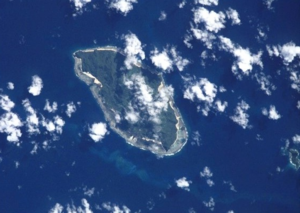Taumako
Taumako is the largest of the Duff Islands. This 5.7 km long island has steep sides and rises to a height of 400 m above sea level. It is composed of basaltic lavas and pyroclastics like the other islands in the Duffs .

The inhabitants of the Duff Islands are Polynesians, and their language, Vaeakau-Taumako, is a member of the Samoic branch of Polynesian languages. On the Duff Islands live about 439 people (1999 census). The islands were settled by the Lapita people about 900 BC. Melanesian settlers followed. Finally Polynesians settlers arrived in the mid 15th-century.
The way of life is traditional by subsistence farming and fishing. Taumako has no roads, airport, telephones, or electricity. Contact with outsiders comes by battery-powered marine radio and the occasional cargo ship.
Traditional Navigation
Studies of David Lewis and Marianne (Mimi) George uncovered that full traditional Polynesian navigational technique is still preserved in these islands (Finney and Lowe, 2006, p163). The people of Taumako are the builders of one of the oldest documented proa sailing canoe, called Te Puke and known to westerners as Tepukei.
Prehistory
People have been living in the Duff Islands for 3,000 years. The first people on these islands made pottery using clay and sand temper which was available locally. A small amount of this pottery was decorated in the distinctive Lapita style with dentate stamping. These first inhabitants made stone tools using high quality chert which was also local. This same chert has been found in archaeological sites in the nearby Reef Islands, dating at least two centuries before the first known evidence in the Duff Islands (Leach and Davidson 2008: 295).
Later archaeological sites dating from AD 1,000 through to the 19th century contain a diverse range of personal ornaments, many of which are similar to those present in ethnographic collections from Santa Cruz displayed in numerous museums around the world. Several of these ornaments can now be shown to be present throughout the 3,000 years of their prehistory. Amongst these are the famous Tridacna shell breast pendants. Several specimens have imprints of fine loom woven cloth, representing the first unequivocal evidence for the presence of the loom in prehistoric Oceania (Leach and Davidson 2008: 190).
Throughout Duff Islands prehistory there is clear archaeological evidence of contact with other Pacific Island peoples from as far afield as the Fiji-Samoa area. This is evident from stone adzes in these islands made from a form of basalt only found in the stone quarries of Tutuila in American Samoa. Most evidence of contact, however, is predictably from closer to Taumako, especially the nearby Santa Cruz region. These wide-ranging external contacts have resulted in a population of people which shows a profound mixture of Melanesian and Polynesian physical features (Leach and Davidson 2008: 245).
Life in the Duff Islands during the prehistoric period was far from idyllic with a high incidence of the infectious disease yaws. This affected children as well as adults and in later life was often debilitating (ibid.: 229). There is also archaeological evidence of inter-personal hostility with deaths being caused by spear wounds. Some of this may have resulted from warfare between different groups, either locally or with arrivals from further afield.
History
The first known European visit to the Duff Islands was the expedition led by the Spanish explorer Quiros in AD 1606. One of the late archaeological sites contained objects made from European materials. Amongst these, a piece of pottery has a mineralogy consistent with Spanish pottery of Quiros' period. In addition a small piece of brass has a chemical composition suggesting the same derivation (Leach and Davidson 2008: 272).
Starting in 1996 the Vaka Taumako project has been working to perpetuate the ancient Polynesian seafaring techniques of the people of Taumako.[1]
Notes
References
- Article on Duff islands
- Ben Finney and Sam Low, "Navigation", in K.R.Howe(eds), "Vaka Moana:Voyages of the Ancestors", Bateman, 2007.
- Leach, B.F. and Davidson, J.M. 2008. The archaeology of Taumako: A Polynesian outlier in the Eastern Solomon Islands. New Zealand Journal of Archaeology Special Publication.
External links
Coordinates: 9°57′S 167°13′E / 9.950°S 167.217°E